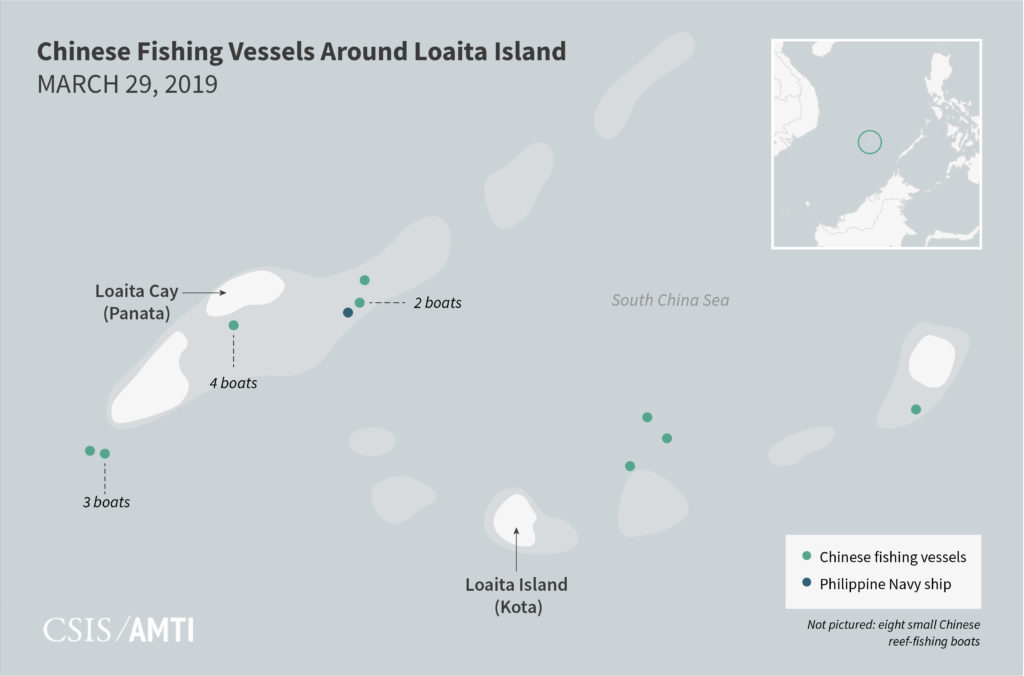Chinese vessels enter 2 more PH islands’ waters

A graphic provided by AMTI shows the position of Chinese vessels near or around Philippine-occupied islands Panata and Kota in the West Philippine Sea on March 29, 2019. AMTI GRAPHICS
MANILA, Philippines — After swarming Pag-asa in the Kalayaan Island Group, Chinese vessels believed to be part of China’s maritime militia have been seen close to two other Philippine-occupied islands in the South China Sea.
Some of the Chinese ships and boats were spotted as close as 1 kilometer off Kota (Loaita) and Panata (Loaita Cay), about 24 km south of Pag-asa (Thitu) Island, the biggest of nine islands and shoals occupied by Filipinos in the Spratly Island chain, according to US-based think tank Asia Maritime Transparency Initiative (Amti).
“Satellite images collected on March 12, 16, and 29, and April 7 confirm the presence of Chinese vessels in the area, most of which show every indication of belonging to the maritime militia,” Amti reported on Tuesday.
“In almost every instance, the vessels are riding at anchor, many in large clusters, and without fishing gear in the water,” it noted.
‘Coercive objectives’
Article continues after this advertisementThe government has protested against the presence of at least 275 Chinese vessels, mostly from China’s maritime militia, during the first three months of the year close to Pag-asa and three sandbars near the island, where the military was working to rehabilitate its facilities.
Article continues after this advertisementIn a statement in early April, the Department of Foreign Affairs (DFA) said the presence of Chinese vessels “in large numbers and for sustained and recurring period, what is commonly referred to as ‘swarming’ tactics” raised questions and concerns about their intent and their role in support of “coercive objectives.”
Amti noted that the presence of China’s maritime militia was apparently “aimed at dissuading Manila from continuing modest infrastructure upgrades on Thitu (Pagasa).”
On Tuesday, it reported that some of the vessels were only 1 km off Panata, “considerably closer than Amti has ever seen militia vessels approach another country’s facility before.”
“This must be particularly provocative for the Philippine detachment on the cay, who likely rely on frequent resupply and relief from those on Loaita Island,” it said.
It noted that Panata had been erroneously called Lankiam Cay in Philippine maps.
One satellite photo showed a 50-meter Chinese fishing trawler near Kota on March 12. Four days later, there were eight. By March 29, at least 15 large Chinese fishing vessels and eight small boats were seen.
Not engaged in trawling
Some of the vessels were just 3.7 km off Kota but most were arrayed around Panata, Amti said.
“None were engaged in trawling or appeared to have fishing gear deployed,” it said.
Vice Adm. Rene Medina, chief of the Western Command, confirmed the presence of Chinese vessels around the two islands.
“They move from one place to another,” Medina told reporters on Tuesday.
The DFA has not commented on the latest reported presence of the Chinese vessels near the two Philippine-occupied islands.
Diplomatic protest
Manila has lodged a diplomatic protest with Beijing against alleged Chinese poachers who had harvested endangered giant clams and destroyed corals at Panatag Shoal, a traditional Philippine fishing ground 230 km west of Zambales province that was seized by Chinese forces in 2012.
Foreign Secretary Teddy Locsin Jr. scoffed at suggestions that Chinese vessels involved in illegal activities were ordinary fishing boats.
“The Chinese (government) is not protecting Chinese fishermen who just happen to swarm there in formation, okay? That’s militia and poachers acting in unison. Period. We’re not stupid or blind,” he tweeted on Wednesday.
Manila was waiting for Beijing’s response to the protest against the harvesting of the giant clams, according to presidential spokesperson Salvador Panelo.
“Perhaps if they will not respond to that affirmatively, then we have to do something more aggressive which may provoke, as I said, armed hostilities,” he said in an interview on ABS-CBN.
He said the Philippines did not want any armed conflict with China and negotiations were still “the best” option to resolve the maritime dispute.
“We can still talk this over. We can tell them ‘Stop doing that,’” he said.
“Otherwise, we will be forced at the risk of an armed conflict, even if minimal,” he added.